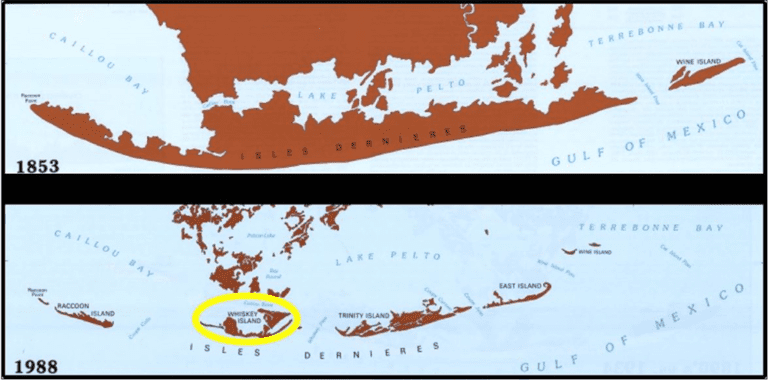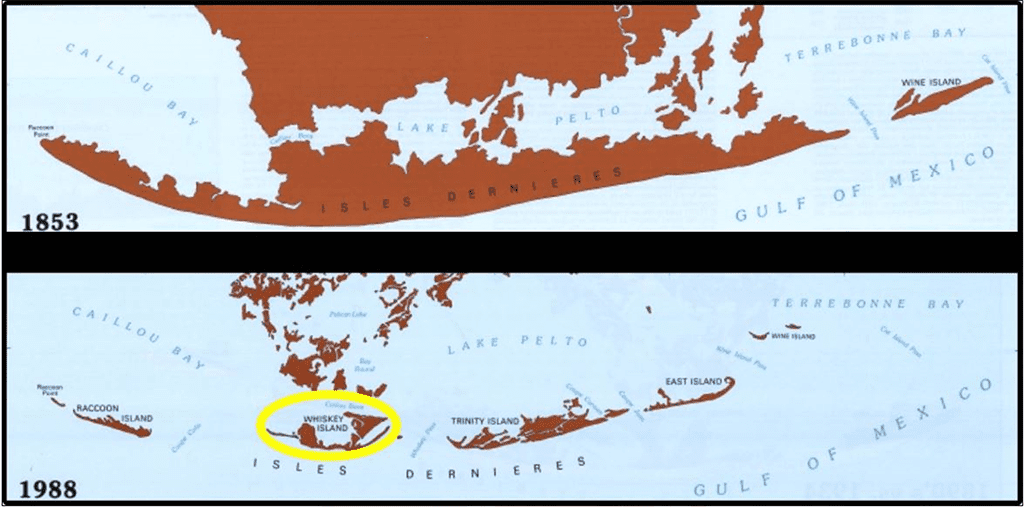Map: a depiction of Isles Dernieres Barrier Island in 1853 and the chain of islands that now make up Isles Dernieres in 1988 after they detached from the mainland (Credit: CPRA).
To restore Louisiana’s coast, we need a suite of large-scale restoration projects across the coast working together to deliver maximum benefits and reduce land loss, restore ecosystems and maintain habitat.
In this “Restoration Project Highlights” series, we’ll be taking a deeper look at specific projects from our list of Priority Projects, highlighting why they’re needed and hearing local perspectives about their importance.
Over the last several decades, and especially ramping up since the 2010 Deepwater Horizon oil disaster, barrier island restoration in Louisiana has been a central tool for protecting coastal wetlands — with over 45 miles of barrier islands being reconstructed since CPRA’s 2007 Coastal Master Plan. Barrier islands serve as the first line of defense in the “multiple lines of defense” paradigm of coastal restoration. By reducing wave action and storm surge, barrier islands protect the wetlands behind them, which in turn protects coastal forests, ridges, levees, roads and human communities.
What is the Caillou Lake Headlands project?
The most recent barrier island restoration project to be completed is Caillou Lake Headlands (a leftover name from when it was once, in fact, a headland connected to the mainland), also known as Whiskey Island. A headland is a piece of land once connected to a mainland to make up a coastline that projects out into the sea. This 5-mile island, along with Raccoon, Trinity and Wine islands, make up the Isles Dernieres barrier island chain located in the middle of Terrebonne Bay.
At a cost of approximately $118 million, funded through the Deepwater Horizon oil spill settlement, contractors pumped about 11.8 million cubic yards of sediment (enough sand to fill the Superdome three times) from Ship Shoal, a remnant barrier island on the floor of the Gulf of Mexico, onto Caillou Lake Headlands to create 1,000 acres. This project now stands as the largest restoration project ever completed in Louisiana, surpassing the Caminada Headland project completed in 2017. This restoration project builds upon a string of barrier island projects in the region, protecting vast coastal wetlands in the Terrebonne and Lafourche parishes. […]
Full article: Explore the Largest Coastal Restoration Project Completed In Louisiana’s History
More about the Coastal Master Plan and Louisiana coastal restoration solutions:
Louisiana Legislature Approves 2017 Coastal Master Plan
Mississippi River Sediment Diversions & Louisiana
Louisiana floods: Tool Lets You See Flood Risk to Your Home
How Can We Create a Sustainable Future for South Louisiana, Navigation and Other Industries?
The Great Barrier Reef of the Americas: Coastal Lessons from the Past


